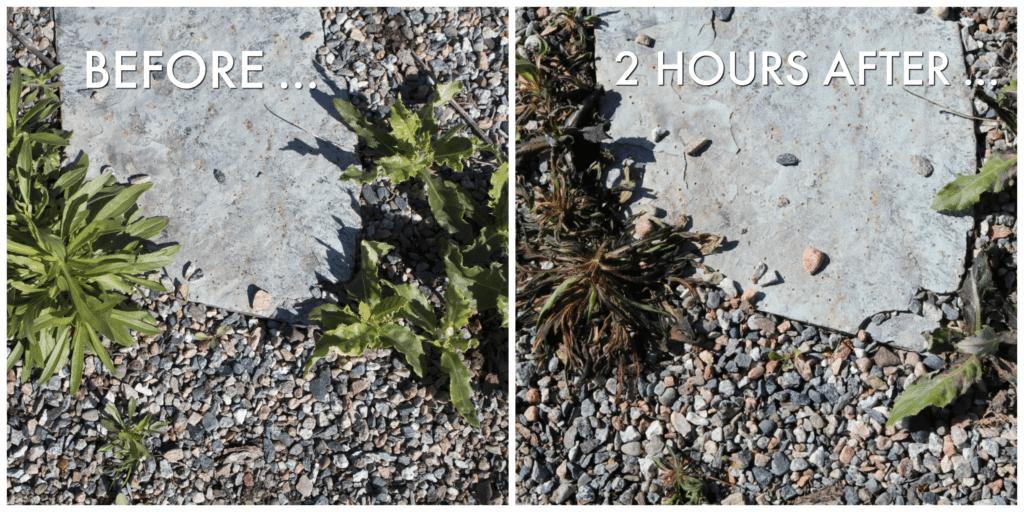If you think there’s no way a DIY homemade weed killer could possibly be effective, even potent, against weeds, think again! But first, a story …

In 1970, John Franz, a chemist for Monsanto, discovered that glyphosate is a potent herbicide that kills almost every plant material imaginable. In no time, the company gave its miracle weed killer the brand name Roundup.
Farmers, especially, went wild for Roundup. Just one problem: It was nearly impossible to kill the weeds without also killing their crops. So Monsanto sent its chemists back to work to develop glyphosate-resistant, or “Roundup ready crops” that have had their DNA altered (genetically modified or GMO) to allow them to be immune to glyphosate. Now farmers could spray with abandon and not worry about their crops.

To say that glyphosate, Roundup, and GMO foods have become a bit controversial would be, to put it mildly. There are some who say that glyphosate causes cancer in animals, and most likely humans, too. They insist that the side effects of long-term GMO food consumption are producing serious health risks for all living things. Despite all of this controversy and outcry about issues surrounding Roundup and GMO crops, so far the Environmental Protection Agency (EPA) has not forced Roundup off the market. It’s a hot-button issue, that’s for sure.
- MORE:: 7 Ways to Wage War Against Mosquitoes—and Win!
Read more : Soap Frosting Tips
There is one provable and very compelling reason not to buy Roundup: It’s too expensive! Even if it were proven beyond a shadow of a doubt that Roundup is safe as water, I still wouldn’t shell out the high price for the stuff. I kill weeds like crazy with kitchen pantry items that are really cheap and non-toxic: white vinegar, ordinary table salt, and dishwashing liquid.
First I will give you the ingredients, followed by two Weed Killer recipes using them:
White vinegar
Ordinary distilled white vinegar with 5% acidity is cheap and works great. If you can find a higher acidity, even up to 20%, it is going to work faster, but the end results will be the same.
Table salt
Use the cheapest kind of salt you can find in the supermarket—NOT sea salt, rock salt, Epsom salts (Epsom salt, chemically, is not even close to table salt, trust me on that) or anything fancy. Just cheap iodized or un-iodized generic salt also known as sodium chloride (NaCl).
Dishwashing liquid
You will be using only a few drops, so the brand doesn’t matter. The purpose of the soap is to break the surface tension of the vinegar so it sticks to the weeds, forcing them to absorb it more readily.
Weed Killer for Areas to be Replanted
If you have weeds in areas you want to replant, fill an ordinary garden sprayer with white vinegar and add about one teaspoon liquid dishwashing soap like blue Dawn or Meyer’s Clean Day. Apply sprayer top and follow the instructions on the sprayer to get it ready to spray. That’s it. Seriously, it is that simple.
Read more : Mayo Parmesan Chicken Bake
Pick a hot, dry day to spray weeds until saturated, and they will wilt and shrivel up within hours. Be careful to not spray anything you want to live. However, do not worry about the vinegar killing anything below the soil. Because vinegar will not harm the soil, you can safely replant the area once the weeds have died.
- READ: Dinner-in-a-Box is Not What I Thought
Weed Killer for Areas Never to Grow Again
To kill all vegetation in walkways, driveways and other areas where you don’t want any living thing to grow again, mix two cups ordinary table salt with one gallon of white vinegar. Do this in a container that is larger than one-gallon capacity so you have room for the salt. Apply the lid and shake to dissolve the salt. Salt dissolves more quickly in vinegar than in water, but it takes a bit of doing. It may not completely dissolve, but that’s okay.
Add 1 teaspoon of liquid dishwashing soap (this is to break the surface tension of the mixture so it will stick to the plant material you’ll be killing). Pour into an ordinary garden sprayer. Apply to weeds or grass on a dry, sunny day to areas you don’t want to see vegetation of any kind in the future.
The presence of salt in this recipe is what will eventually bring permanence to your weed killing. The salt will penetrate and leach into the soil. It may take several applications, but in time the presence of salt will “sterilize” the soil in this area so that nothing will grow there. Plan well before you go this permanent route.
Non-Toxic to Humans, Pets
These homemade weed killer recipes are not only cheap, but both are also completely non-toxic to humans and animals. In fact, except for the soap (not toxic, but not very tasty), you could have fun with the family tonight when you tell them you made the salad vinaigrette using 3 parts olive oil to 1 part weed killer!
- MORE: How to Make Non-Toxic Natural Pest Control
Everyday Cheapskate participates in the Amazon Services LLC Associates Program, an affiliate advertising program designed to provide a means for us to earn from qualifying purchases at no cost to you.
More from Everyday Cheapskate
Please keep your comments positive, encouraging, helpful, brief, and on-topic in keeping with EC Commenting Guidelines
Caught yourself reading all the way ’til the end? Why not share with a friend.
Source: https://gardencourte.com
Categories: Recipe


